Understanding bilateral coordination: A key skill for your child
- waterbabies

Bilateral coordination is the movement of both arms, or both legs, together. The movements can be made at the same time with both arms, like raising them to make a ‘T’ shape, or alternate like using one hand to hold paper still while the other cuts it with scissors.
Many, if not most, of the tasks we do each day require us to use bilateral coordination, and often to control and combine our movements so that our hands (or arms, or legs) are working together to achieve the same goal.
Young children can appear to be uncoordinated or clumsy when they are learning some of these skills as they are still learning how to control their bodies to achieve bilateral coordination.
They will learn through having lots of opportunities to move while they play, and by being given time to try, fail and try again when tasks are tricky.
Activities you might enjoy together like having a trip to play on the swings or a visit to the swimming pool, can support your child to develop their physical skills.[1]
To make it even harder for them, they have to learn various forms of coordination and match the right one with the task they’re trying to complete.
The different kinds of bilateral coordination are:
Movements at the same time – symmetrical
Examples include: jumping with two legs together, pushing a buggy, using a rolling pin, swinging and clapping hands.
Moving two limbs in opposite directions – reciprocal
Examples include: climbing stairs, walking, riding a bike and hopscotch.
Alternate movements – asymmetrical
Examples include: fastening a zip, using a knife and fork, using scissors, threading and opening containers.
Reference:
[1] Borioni, F., Biino, V., Tinagli, V., & Pesce, C. (2022). Effects of baby swimming on motor and cognitive development: a pilot trial. Perceptual and motor skills, 129(4), 977-1000.